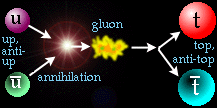
During an annihilation, a matter and antimatter particle interact with each other, converting the energy of their previous existence into a very energetic force carrier particle (a gluon, W/Z, or photon). These force carriers, in turn, may decay to other particles.
Quite often, physicists will annihilate two particles at tremendous energies in order to create new, massive particles. Many events can involve annihilations, weak and/or strong interactions. Go to the next page to look at several examples.